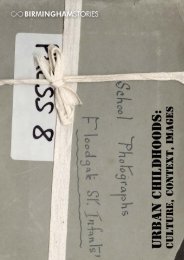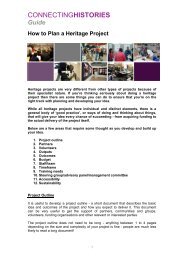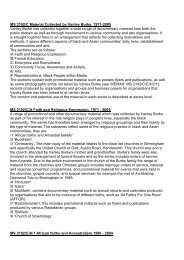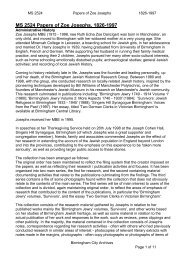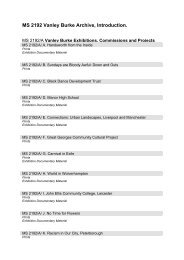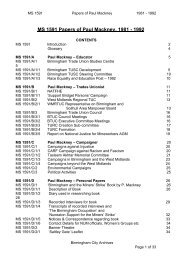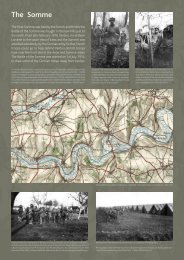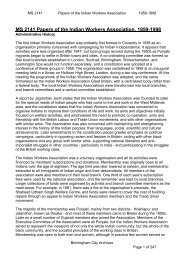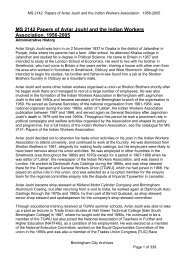download this trail - Connecting Histories
download this trail - Connecting Histories
download this trail - Connecting Histories
Create successful ePaper yourself
Turn your PDF publications into a flip-book with our unique Google optimized e-Paper software.
6. Victoria Square<br />
As the centre of local government in Birmingham, Victoria Square is a good setting to<br />
talk about campaigns for Jewish civil rights.<br />
The first Jew to serve on the Birmingham Town Council was called David Barnett,<br />
elected in 1839. He was a prominent member of the Jewish community and active in<br />
local politics in the city, serving on the Board of the Queen Elizabeth Hospital, the<br />
Jewish Board of Guardians, and many of the Committees that managed the affairs of<br />
his synagogue. He was one of several members of the Congregation who set up the<br />
Birmingham Hebrew School. His election was an important moment in Birmingham's<br />
history. Town Councillors were required by law to swear an oath of allegiance 'on the<br />
true faith of a Christian'. David Barnett, as a Jew, could not take <strong>this</strong> oath. However,<br />
after some discussion, 'the Council allowed that Mr Barnett take the declaration<br />
conscientiously with the omission of the words, for his religion strictly commanded<br />
Israelites that wherever they might be, they were duty bound to support the<br />
establishment of that country.' Although David Barnett was elected in 1839, a bill<br />
permitting Jews to hold municipal office was not passed until 1845, and almost twenty<br />
years passed before, in 1858, Lionel de Rothschild became the first Jewish MP to take<br />
his seat in Parliament, swearing the oath "So help me, Jehovah".<br />
The Council House was designed by the Birmingham architect Henry Yeoville<br />
Thomason, who, earlier in his career had built Singers Hill Synagogue.<br />
Walk away from Victoria Square down New St and turn left on Bennetts Hill.<br />
Stop at no 11, on the left side of the street.<br />
7. Bennetts Hill<br />
10, Bennetts Hill was the home and business premises of David Barnett, who<br />
was a jewellery merchant. He lived there with his business partner Samuel<br />
Neustadt and their families. Some of the Victorian buildings on <strong>this</strong> street have<br />
disappeared, but you can still see a blue plaque marking the site of no 11 which<br />
was the birthplace of the artist Sir Edward Burne-Jones. When he was a child in<br />
the 1830s, the young Edward was close friends with the children next door; his<br />
mother's memoirs include descriptions of life in the Neustadt/Barnett household.<br />
‘The household was a Jewish one, and almost patriarchal in character; for the<br />
two partners of a firm of merchants established in Birmingham, Messrs.<br />
Neustadt and Barnett, had married two sisters, and both families including<br />
children, a widowed mother, and a maiden aunt, lived together under the same<br />
roof...They shared all their pleasures and amusements with [Edward], nor was<br />
he excluded even from their holy days and festivals. At the Feast of Purim he<br />
dressed up with the other children, and was so eager for the merry-making that<br />
when the day came round, he was always the first guest to arrive.’<br />
Bertram Silverston, who was Chairman of the Congregation's governing Council<br />
and a Trustee in the 1920s - 1940s, lived at 16 Bennetts Hill.<br />
Walk back down Bennetts Hill and turn left onto New Street. Walk down New<br />
Street looking for the Odeon cinema on your right and stop outside.<br />
5



